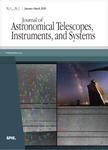版权所有:内蒙古大学图书馆 技术提供:维普资讯• 智图
内蒙古自治区呼和浩特市赛罕区大学西街235号 邮编: 010021

作者机构:University of Notre Dame Department of Physics and Astronomy Notre DameIN United States Max-Planck Institute for Astronomy Heidelberg Germany
出 版 物:《Journal of Astronomical Telescopes, Instruments, and Systems》 (J. Astron. Telesc. Instrum. Syst.)
年 卷 期:2025年第11卷第1期
核心收录:
学科分类:0808[工学-电气工程] 0709[理学-地质学] 0809[工学-电子科学与技术(可授工学、理学学位)] 07[理学] 070401[理学-天体物理] 0708[理学-地球物理学] 0804[工学-仪器科学与技术] 0805[工学-材料科学与工程(可授工学、理学学位)] 0802[工学-机械工程] 0703[理学-化学] 0704[理学-天文学] 0825[工学-航空宇航科学与技术] 0811[工学-控制科学与工程] 0702[理学-物理学] 0801[工学-力学(可授工学、理学学位)]
主 题:Adaptive optics Simulations Contour extraction Wavefronts Wavefront reconstruction Scanning probe microscopy Correlation coefficients Reconstruction algorithms Pupil aberrations Wavefront sensors
摘 要:The nonlinear curvature wavefront sensor (nlCWFS) uses multiple (typically four) out-of-focus images to reconstruct the phase and amplitude of a propagating light beam. Because these images are located between the pupil and focal planes, they contain tip/tilt information. Rather than using a separate sensor to measure image locations, it would be beneficial to extract tip/tilt information directly and routinely as part of the reconstruction process. In the presence of atmospheric turbulence, recovering precise centroid offsets for each out-of-focus image becomes a dynamic process as image structure is altered by changing aberrations. We examine several tip/tilt extraction methods and compare their precision and accuracy using numerical simulations. With knowledge of the z-distance to each plane, we find that applying a best-fit linear model to multiple image centroid locations can offer fast and accurate tip/tilt (jitter) mode retrieval. We also develop a nonlinear tip/tilt extraction method that self-consistently uses the speckle field to compensate for jitter but find that algorithm latency precludes practical implementation. Simulations of closed-loop adaptive optics correction demonstrate that centroiding precisions may reach the diffraction limit despite using images with a finite region of interest that is purposefully defocused. © 2025 Society of Photo-Optical Instrumentation Engineers (SPIE).